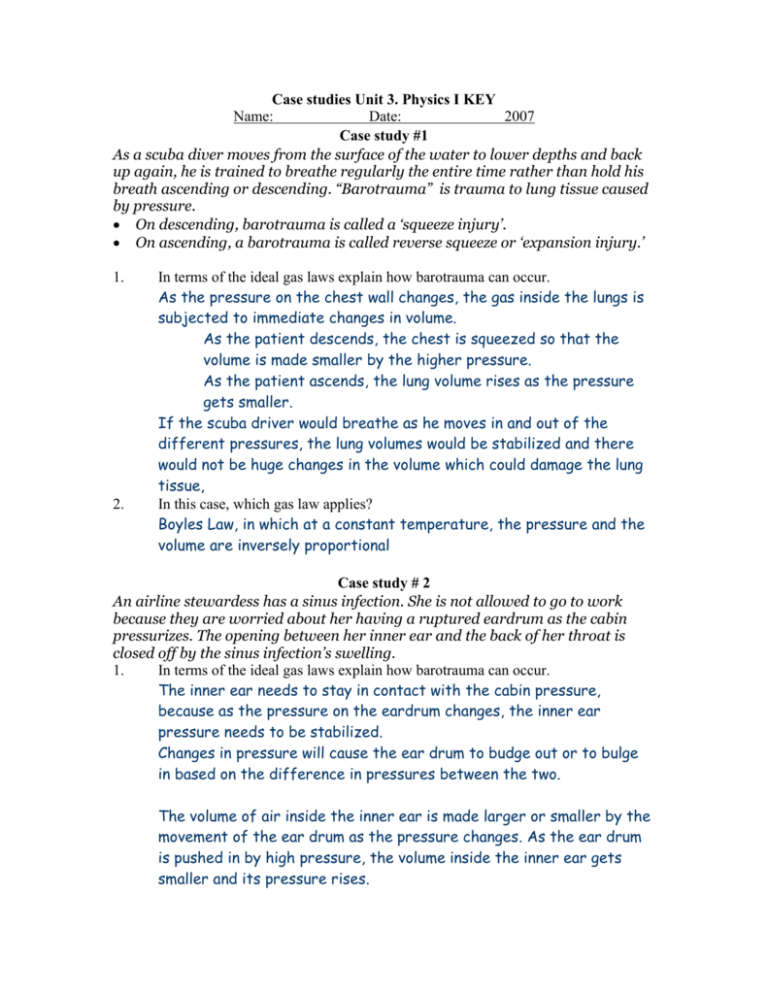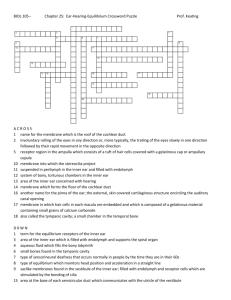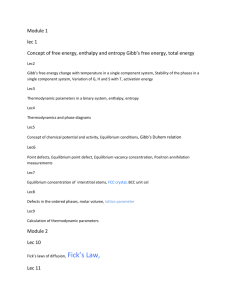Case studies Unit 3
advertisement

Case studies Unit 3. Physics I KEY Name: Date: 2007 Case study #1 As a scuba diver moves from the surface of the water to lower depths and back up again, he is trained to breathe regularly the entire time rather than hold his breath ascending or descending. “Barotrauma” is trauma to lung tissue caused by pressure. On descending, barotrauma is called a ‘squeeze injury’. On ascending, a barotrauma is called reverse squeeze or ‘expansion injury.’ 1. 2. In terms of the ideal gas laws explain how barotrauma can occur. As the pressure on the chest wall changes, the gas inside the lungs is subjected to immediate changes in volume. As the patient descends, the chest is squeezed so that the volume is made smaller by the higher pressure. As the patient ascends, the lung volume rises as the pressure gets smaller. If the scuba driver would breathe as he moves in and out of the different pressures, the lung volumes would be stabilized and there would not be huge changes in the volume which could damage the lung tissue, In this case, which gas law applies? Boyles Law, in which at a constant temperature, the pressure and the volume are inversely proportional Case study # 2 An airline stewardess has a sinus infection. She is not allowed to go to work because they are worried about her having a ruptured eardrum as the cabin pressurizes. The opening between her inner ear and the back of her throat is closed off by the sinus infection’s swelling. 1. In terms of the ideal gas laws explain how barotrauma can occur. The inner ear needs to stay in contact with the cabin pressure, because as the pressure on the eardrum changes, the inner ear pressure needs to be stabilized. Changes in pressure will cause the ear drum to budge out or to bulge in based on the difference in pressures between the two. The volume of air inside the inner ear is made larger or smaller by the movement of the ear drum as the pressure changes. As the ear drum is pushed in by high pressure, the volume inside the inner ear gets smaller and its pressure rises. As the pressure on the ear drum is less, the bulging out of the structure will make the volume inside the inner ear gets larger, so that its pressure rises. 2. In this case, which gas law applies? Boyles Law, in which at a constant temperature, the pressure and the volume are inversely proportional. As the volume of the inner ear is made smaller by the pressure increase, the pressure inside the inner ear gets higher. Case study # 3 Your patient has had two lobes of his 5 lobes removed from his lung due to lung cancer. As a result, his Pa02 on room air is 57 mmHg. 1. In terms of Fick’s Law, why is the diffusion of 02 hampered by his disease. The removal of 2/5th of the lung’s tissue will make the surface area of the lung decrease. This decrease of surface area will cause a decrease in the diffusion of 02 from the alveoli into the blood stream. The surface area is directly proportional to the rate of diffusion 2. What steps might we take to get the Pa02 back up to normal? We can increase the gradient between the alveoli and the capillary bed so that diffusion happens faster. Case study # 4 Your patient has a chronic pneumonitis in which the alveolar wall has been replaced by scar tissue over a period of a few years. 1. In terms of Fick’s Law, explain why diffusion of 02 is hampered by his disease. Due to increased thickness of the membrane, diffusion is slowed down. The thickness of the membrane is inversely proportional to the rate of diffusion of a gas 2. You look at an Arterial blood gas [ABG] and see the following: pH 7.423306 PaC02 38 HC0324 Pa02 58 You notice that the PaC02 is unaffected; in terms of Fick’s Law, why is the c02 less effected than the Pa02. The C02 diffuses 19 x faster than 02 does and only the huge pressure gradient between PA02 and P capillary 02, makes equilibration of 02 possible in the same timeframe. If we lose this huge gradient because alveoli are filled with fluid rather than air, then 02 has lost its only advantage. Case study # 5 Your patient is up on top of a mountain where the Pb is only 480 mmHg. This mountain climber is young and healthy. 1. In terms of Fick’s Law, why is the diffusion of 02 hampered by his disease. The Pi02 is dependent on the Fi02 and on the Pb Due to the tiny barometric pressure, we have lost the huge pressure gradient between PA02 and P capillary 02 2. How do you think he will try to compensate for this problem? Because he will be hypoxemic, we will see the s/s of hypoxemia: increased heart rate, respiratory rate. If the Sp02 drops too much we will have cyanosis. Increased WOB will be seen the use of accessory muscles as well as sweaty skin. Case study # 6 Your patient has an infection of his alveoli [pneumonia] so that instead of being filled with air, the alveolar sacs are filled with secretions. 1. In terms of Fick’s Law, why is the diffusion of 02 hampered by his disease. His surface area for gas exchange is decreased, so that diffusion is decreased. The rate of diffusion of gas is directly proportional to surface area available for gas exchange 2. How do you think he will try to compensate for this problem? Because he will be hypoxemic, we will see the s/s of hypoxemia: increased heart rate, respiratory rate. If the Sp02 drops too much we will have cyanosis. Increased WOB will be seen the use of accessory muscles as well as sweaty skin.







